Skip to Content
|
Hooke's Books Home > Hooke's Influence
|

|
Antoni van Leeuwenhœk (1632-1723) was Hooke's greatest student, rival, and successor in the world of microscopy. Although the two never met, Leeuwenhœk was clearly influenced by Hooke's accomplishments; he too ground his own lenses and built his own equipment. In his early years, Leeuwenhœk sent his findings to the Royal Society in London (Hooke's long-time employer), where they were published in the society's Philosophical Transactions, the first peer-reviewed scientific journal. Leeuwenhœk's later instruments were far stronger than Hooke's, and allowed him to see microscopic structures too small for Hooke's equipment to capture.
|
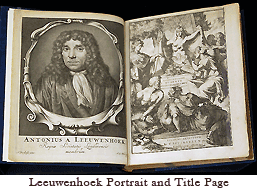
Antoni van Leeuwenhœk
Ontdeckte Onsigtbaarheeden
6 Volumes; Leiden, 1685-1718.
Leeuwenhœk's collected works, showing the engraved portrait title page.
See the NLM catalog record
|
|
| |
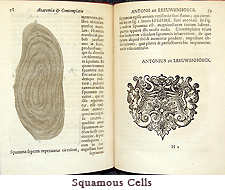
Antoni van Leeuwenhœk,
Anatomia et contemplatio nonnullorum naturae invisibilium secretorum comprehensorum epistolis quibusdam scriptis ad ... Societatis Regiae Londinensis Collegium
Leiden, 1685
This volume is actually a Latin translation, printed in the Netherlands, of letters originally published by the Royal Society in London. The illustrations show squamous cells found inside the mouth: one of the first reprensentations of cells from the human body.
See the NLM catalog record
|
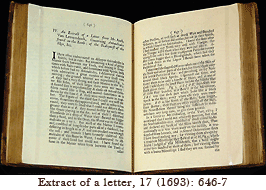
An Extract of a Letter from Mr. Anth. Van Leuwenhoek, concerning Animalcules Found on the Teeth; Of the Scaleyness of the Skin, &c. Philosophical published in the Philosophical Transactions, 17 (1693): 646-647.
See the NLM catalog record
|
|
Robert Hooke (1635-1703) was the great pioneer, but he was not alone. There had been a few who attempted what Hooke would famously accomplish, and many others who would follow, expanding and refining what Hooke had done by reading the tracts he left for them. Henry Power published before Hooke, but Power's book has only a few crude woodcuts. William Derham edited some of Hooke's works posthumously, including illustrations never before published. Henry Baker drew precise plans for building microscopes that clearly used Hooke's instrument as their inspiration.
|
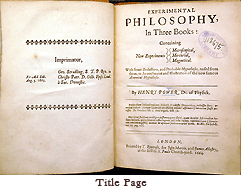
Henry Power, Experimental philosophy, in three books : containing new experiments microscopical, mercurial, magnetical ; with some deductions, and probable hypotheses, raised from them, in avouchment and illustration of the now famous atomical hypothesis. London, 1664
See the NLM catalog record
|
|
| |
![Hailstones from Philosophical experiments and observations of the late eminent Dr. Robert Hooke ... : and other eminent virtuoso's [sic] in his time ; with copper plates publish'd by W. Derham, F.R.S., London, 1726](images/hailstonessmall.gif)
Robert Hooke, Philosophical experiments and observations of the late eminent Dr. Robert Hooke ... : and other eminent virtuoso's [sic] in his time ; with copper plates publish'd by W. Derham, F.R.S.. London, 1726
See the NLM catalog record
|
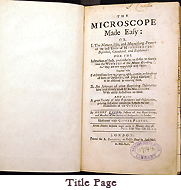
Henry Baker, The microscope made easy : or, I. The nature, uses, and magnifying powers of the best kinds of microscopes described, calculated, and explained : for the instruction of such, particularly, as desire to search into the wonders of the minute creation, tho' they are not acquainted with optics : together with full directions how to prepare, apply, examine, and preserve all sorts of objects, and proper cautions to be observed in viewing them : II. An account of what surprizing discoveries have been already made by the microscope: with useful reflections on them : and also a great variety of new experiments and observations, pointing out many uncommon subjects for the examination of the curious. London, 1742
See the NLM catalog record
|
|
Last reviewed: 01 August 2008
Last updated: 01 August 2008
First published: 01 August 2008
Metadata| Permanence level: Permanent: Stable Content






![Hailstones from Philosophical experiments and observations of the late eminent Dr. Robert Hooke ... : and other eminent virtuoso's [sic] in his time ; with copper plates publish'd by W. Derham, F.R.S., London, 1726](images/hailstonessmall.gif)
